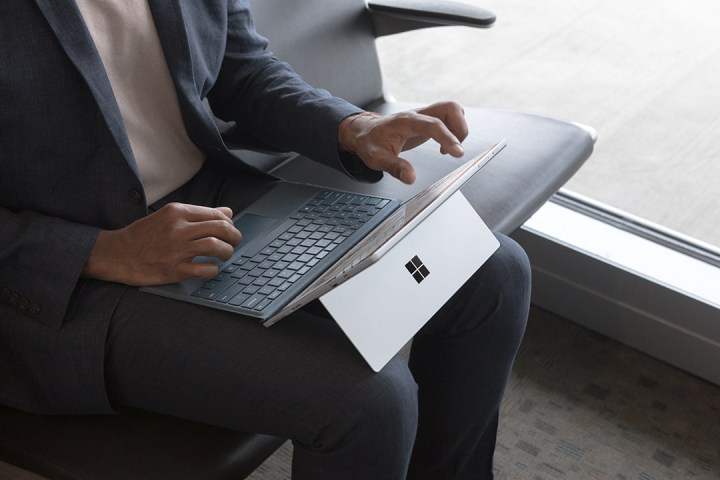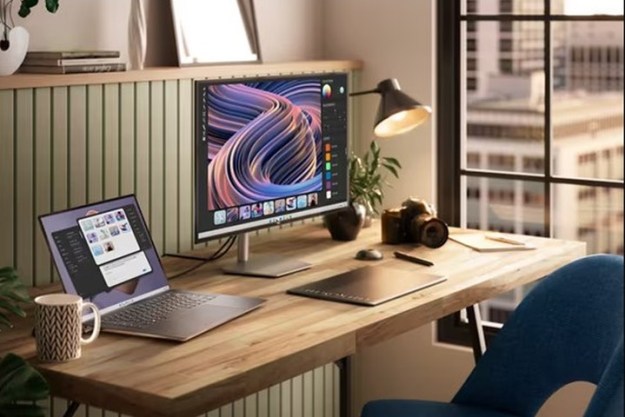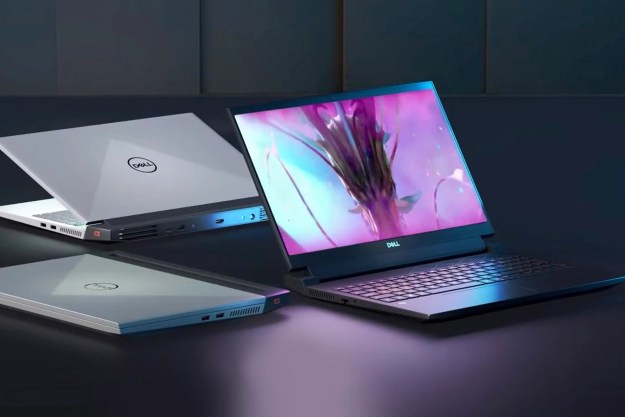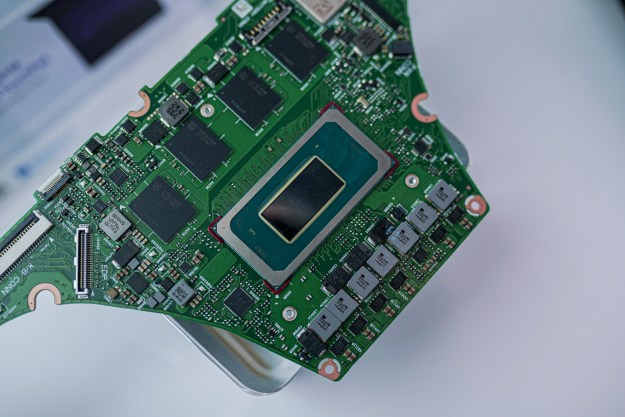
“When we launched the very first Surface Pro five years ago, there was a snowstorm in New York. We’d planned to have our launch at a Best Buy in Manhattan, but the weather had other ideas.”
That’s Panos Panay, the passionate Microsoftie who’s been the face of so many Surface product launches over the last five years. Panay wrote a blog post on the Microsoft site this week to celebrate the 5-year anniversary of surface, to reminiscence on how the team dealt with the storm (they moved the show to Vegas). He’s always quick to remind us about the team behind the products — the designers and engineers responsible for the most remarkable 2-in-1 to hit stores shelves in years.
Among them are minds like Steve Bathiche, a distinguished scientist who has been there from the start. “We realized when we had heavy competition from Apple, that we had to innovate in the PC space,” Bathiche told us recently. There’s also Ralf Groene, head of Industrial Design with the Microsoft Devices group, and the man most responsible for the look and feel of the products.
And there’s Microsoft GM Pete Kyriacou, the man who make sure everything happens right, and right on time. On the five-year anniversary of the Surface Pro line, Digital Trends sat down with Kyriacou to compare the products Microsoft released then and now. How has the design philosophy changed, how have the products evolved, and is there really a storage room full of wacky concept prototypes? (Spoiler alert: yes.)
This interview has been edited and condensed for publication.
Congratulations! Microsoft launched the Surface Pro five years ago this month — you must be a very proud parent!
Pete Kyriacou: Yeah! I didn’t have kids at the time, and I have a three-year-old daughter now, and a six-month-old son. And so, at the time [the Surface devices] meant the world to me, they were my babies. They’ve since been replaced, but the Pro has a spot in my heart, for sure.
Can you talk a little about how the design and engineering has evolved over time? How has your thought process changed from the first products you worked on to what you’re working on today?
The people have stayed the same. We’ve had the same engineers and team in the building. We are doing little shindigs for our five-year, and it’s funny to see the people turn out. You’re like, woah, this group has gotten so large, but the core team has remains intact.
“We’ve formed a relationship with Intel where we feel like we’re pushing the limits on what they’re doing and we’re doing.”
The things that have changed, I think is the impact we have made on the industry specifically in the three main areas we work on when we work on our devices. We focus on making great displays — that’s the main interaction people have with their computers. Look back to the displays we used on Surface Pro 1, 2, and it’s 16×9 aspect ratio. Although it was HD and had good specs from a display perspective, we changed a lot in the display industry. We pushed hard to get thinner modules. We locked onto these 3×2 aspect ratio which we feel improves productivity, and that’s across the board on all our products.
The second thing is materials, the form factor. We’ve been able to get really thin, we’ve homed in on magnesium, and we’ve done some really good stuff with aluminum. And then also on being able to dissipate thermals. So, putting 15 Watts into Pro 1 required two fans to dissipate the heat, and if you ever used a Pro 1 device, you could probably hear it. We’ve come a long way in being able to dissipate 15 W in a thinner form factor without having to have any moving parts, and it’s pretty incredible.
And the last part of the trifecta is processors. We’ve formed a relationship with Intel where we feel like we’re pushing the limits on what they’re doing and we’re doing, and it’s been great teamwork. And we’ve seen from performance — how devices Turbo — to what they’re doing when they’re asleep — what we call “connected standby,” or when you’re in hibernation in terms of low power drainage. The first version of Pro had around four of five hours of battery; we went up incrementally between iterations, but the next biggest leap we made other than Pro 1 or Pro 2 was Pro 4, the latest generation. We went from 9 hours to 13.5 hours. Part of that was adding physical battery, and keeping the weight the same because we got rid of the fans. Part of it was optimizations in the silicon of Intel, and a big part of it was pushing Windows and the work we have with Windows, as just one team now, in terms of optimizing the power state.
How do you think public perception of the product itself has changed? There was a lot of interest when the first Pro came out, but maybe not as much as the sales Microsoft might have wanted…was there a point at which you felt the momentum really shift?
You can see where it changed: Surface Pro 3. Pro 3 was something we had envisioned early on, like when we were making Pro 1, we had an idea of where the thing was going to go. We knew the 3×2 aspect ratio was something we wanted to do, but that was a custom display. It was hard to go in and make custom displays for yourself when you weren’t yet an established brand. And that is something we do now that’s totally normal. All our displays are something you don’t see anywhere else. All the way down to the aspect ratio and the pixels.
“It was hard to go in and make custom displays for yourself when you weren’t yet an established brand.”
When we came out [with Pro 1] people said, “are you a concept car, are you an aspirational brand, are Pro 1 and 2 what OEMs should go out and drive?” But when Pro 3 came out and we showed the actual productivity increase at the price points we were able to hit, and the form factors we were able to drive, you saw the whole industry starting to follow what we were doing. It wasn’t long before OEMs were able to go in and start selling at these higher prices after Pro 3 was in there.
Then you saw other people copying our form factors. You saw other people saying, yeah, this tablet device is thin and light and people carry it, but they want a keyboard to go with it. They want a pen to go with it. OEMs are doing it. Apple’s doing it. You see that we led the industry.
Surface was about Microsoft executing in a way that hadn’t happened before. There were thin and light notebooks for a decade before this. It took the Surface Pro line to say, here’s how this is supposed to work.
Product making is interesting, because if you think about physical atoms, it’s like a chef. Everyone has the same ingredients to start with. How do you find the right balance of what you want to do? You can make something super thin, but the battery might not be that great, and the performance might not be that great. You can make awesome battery life, but you’re sacrificing thickness or something else. Finding that right combination of the recipe for the customer and the experience you’re going for is really where the magic lies in our culture.
The other thing that’s changed is that, on campus, our hardware capability has expanded tremendously. Building 87, the lab we’ve created, has over 100,000 square feet of CNC machines, anechoic chambers, test facilities that let us go from an idea to testing that idea in 24 hours.
I bet there’s a back room somewhere with all sorts of prototypes and weird looking form factors of early Studio, early Laptop…
There’s tons, just stacks and stacks of models. We call it failing fast. The good and bad of having this lab on campus is you can pound out SLA models overnight. And that’s awesome, but then you also have this, well I have this idea, I have this idea, and it goes on and on. We are good about letting engineers be engineers. I think we have one of the most talented teams on the planet when it comes to processors, thermals, mechanics. And how they work with designers to understand the design intent and customers experience. And then the go.
“When they see Studio, they’re going to be blown away.”
Surface Studio? We knew what the feel was going to be because we asked an engineer to go nail the feel. And he’s like, well, what do I have to work with? And we said anything. So, they stole a desk from the conference room and they butchered it up and built a counterbalance that was about 4 feet long. And they were able to take the pin out and put it in at different lever points and say, what would a 28-inch screen feel like with this lever point, with that lever point. And they brought it in to our design team and our user research team and human factors team, and they said, this is exactly what it should feel like. And once you’re clear on what your goals are, then the great engineering team can succeed.
Is there some obvious idea you had in some early prototype that you wish you had done, something still waiting for a new iteration down the road?
The one or two times I had that feeling? One was, we were launching Pro 2, and Pro 3 was pretty far along in development, and it felt pretty good knowing that. And we had an awesome device in Pro 2 — the battery life was great, the screen was great. But knowing that we were making the bigger screen, lighter weight device that still improved the battery life, was one time I had that feeling you’re talking about.
The next one was when Surface Studio was in development. And you watch people at their desks and you’re like, no one has a 3×2 display, no one has a display they can write on. How natural and intuitive would it be for these people that are either on traditional all in ones or traditional desktops — when they see Studio, they’re going to be blown away.
That device, in its iterations, it got to the point where it had clutch mechanisms and brakes, so it would stop at different angles and lever arms and stuff like that. And they were all great concepts on a PowerPoint. They weren’t great from a user experience or even a concept perspective.
Believe me, our engineers made pneumatic systems that could stop on a dime and you could write on it — is that what the user wants? Does that keep you in your flow? And so, I’m happy with the stuff we’ve left behind as we’ve iterated and launched these products.
Editors' Recommendations
- The most powerful Surface laptop ever may launch later this year
- Everything announced at the Surface event: Duo 2, Surface Laptop Studio, and more
- Microsoft says Thunderbolt 3 is not safe for Surface products




